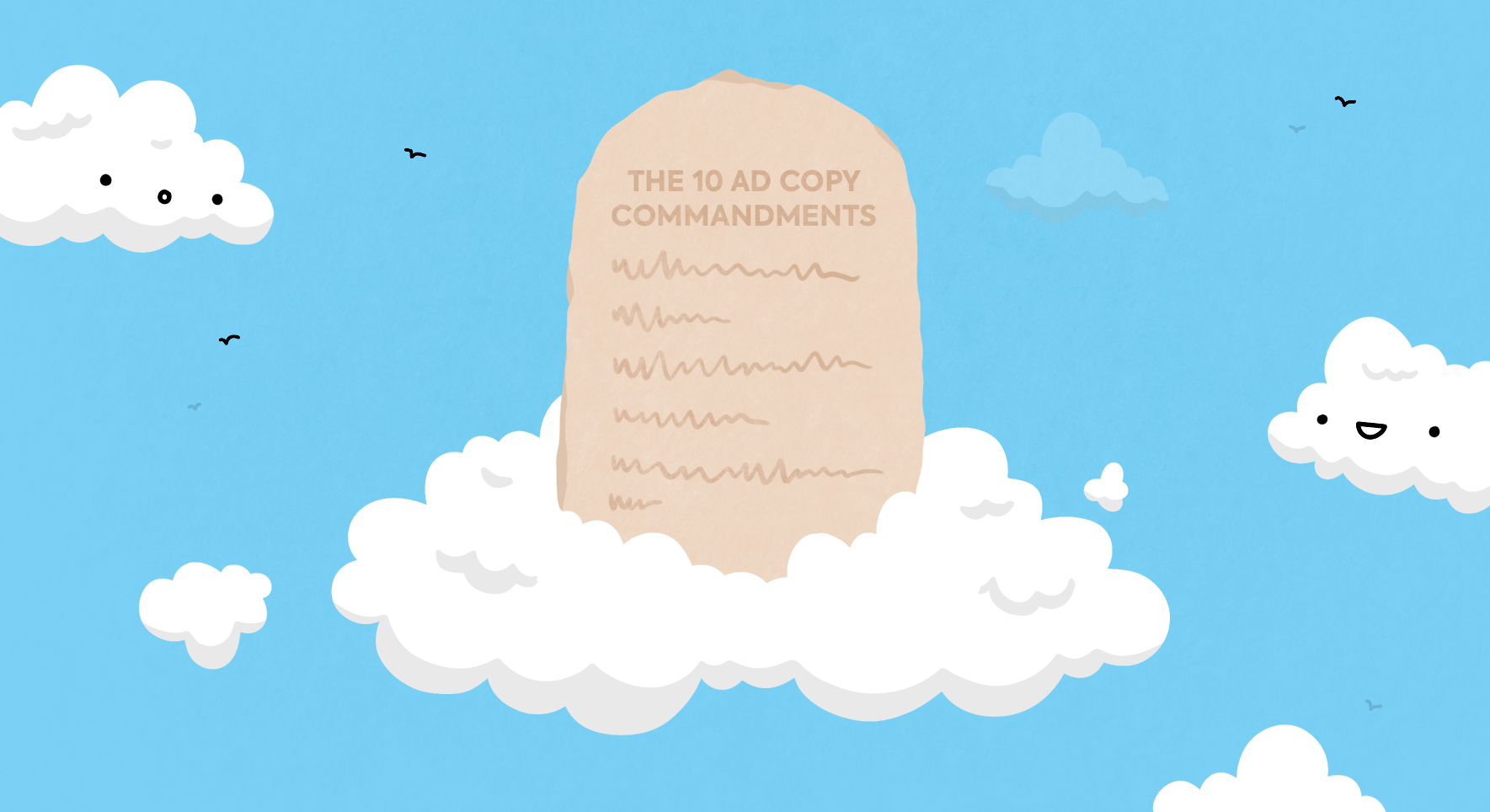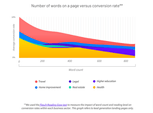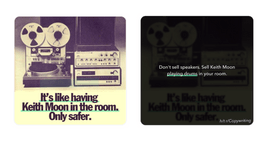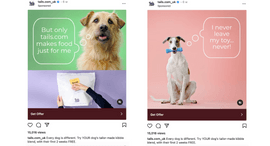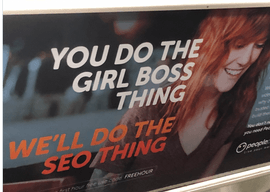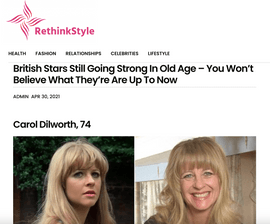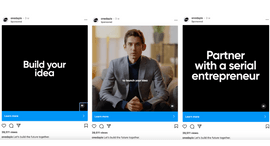Writing ad copy isn’t easy. 80% of people who see your ad won’t make it past the headline. Which is why it’s so important to know how to write ad copy that sells.
According to Peter Koechley, former editor of The Onion and co-founder of Upworthy, headlines are critical:
“The difference between a good headline and a bad headline can be just massive. It’s not a rounding error. When we test headlines we see 20% difference, 50% difference, 500% difference. A really excellent headline can make something go viral.”
But even when you’ve managed to get someone to read beyond your headline, there are challenges. Landing pages also tend to perform better if there are fewer words on the page. So as an ad copywriter, your goal is to help your target audience see the benefit of your product in as few words as possible.
Compelling ad copy is concise and emotive. Here’s an example, courtesy of Harry from MarketingExamples.com:
This clever ad copy doesn’t tell you anything about the speakers. It doesn’t even lay out the benefits. There’s no need when this ten-word caption is so convincing. The writer knows who their target audience is, and what will captivate them. It even includes an if-you-know-you-know reference.
It takes a lot of time and testing to get your ad copy right. But by following these ten ad copywriting commandments, you can write PPC ad copy, landing pages, blogs, and emails that convert prospects into customers. We’ve also included illustrative examples throughout to help you define great (and some not-so-great) ad copy examples.
Ready to learn how to write ad copy that sells? Let’s dive in.
TL;DR: 10 Commandments for Ad Copy That Sells
Here’s a quick TL;DR guide to the ten commandments of ad copywriting:
- Sell the sizzle, not the steak — Avoid listing product features. Instead, talk about the outcome, experience, and benefits of what you’re selling.
- Keep it concise — Don’t waste people’s time. Grab their attention and get to the point quickly so you don’t lose them.
- Be a human, not a robot — Good ad copy is relatable and easy to understand. Avoid jargon and keep it conversational.
- Make it personal — Don’t talk to the crowd. Use personal pronouns like “you” and “your” to talk directly to your audience, making your message more personal and impactful.
- Don’t talk down to people — Avoid patronising and stereotyping your audience; it won’t do your brand any favours.
- Avoid clickbait — Don’t make promises in your ad or landing page that you can’t fulfil with your product or service.
- Start with action verbs — Words like “discover” and “explore” can inspire people to take action.
- Speak to the ego — Tap into people’s self-referential thinking by indicating how your product or service can positively affect their life.
- Tap into FOMO — Fear of missing out can create urgency and desire in your customers, so tapping into this can be lucrative.
- Don’t copy your competitors — Research competitor ads, but don’t copy them. You won’t stand out if your messaging is the same as everyone else’s.
How to Write Ad Copy That Sells: The 10 Commandments
These ten commandments of interesting, honest advertising copy can help you improve conversions and make the most of your marketing budget. Take this advice from advertising tycoon David Ogilvy:
“Tell the truth, but make the truth fascinating. You know you can’t bore people into buying your product. You can only interest them into buying it.”
Here’s how to write ad copy that sells.
1. Sell the Sizzle, Not the Steak
Selling the sizzle, not the steak, means marketing the experience of your product, rather than the product itself.
Take this ad from Vrbo, a homestay booking company. The ad offers a glimpse of the home exterior; it doesn’t show the interior at all. Instead, it sells the experience: a private family trip full of anticipation and excitement.
The product is still front and centre of this ad, but the references are subtle. Vrbo could have simply said “stay in a cosy log cabin with a cosy fireplace.” But this would be selling the steak.
Instead, the smart copy includes lines like, “we get to stay here all weekend!” and “we can snuggle up by the fire”. This gives you the same information, but also creates a compelling sense of wanderlust and anticipation. This is selling the sizzle.
2. Keep It Concise
Keep your ad copy direct and to the point. This has multiple benefits:
- You won’t waste people’s time
- You’re more likely to retain readers
- You can improve your conversion rate.
Some of the best ads have minimal copy. This classic UK ad has a two-word script and a two-word tagline:
Granted, this matches the brand’s voice. You can’t have a tagline like “no nonsense” and then go on to describe the drink’s flavour in intricate detail. But, like the Keith Moon speaker ad above, it proves that you don’t need reams of copy to sell your product.
These tips will help you keep your ad copy concise:
- Every word should fight for its place in the text — remove flowery adjectives and adverbs
- Be ruthless when condensing your text
- Challenge yourself to use as few words as possible.
In PPC search advertising, your ad descriptions and headlines will be cut off if they’re too long. Both these Google ad examples have had their descriptions cropped:
3. Be a Human, Not a Robot
Some ad copywriters fall into the trap of using jargon and clichéd language when talking about their business. B2B brands are the worst offenders here.
Let’s compare these two search ads, both of which are running for the term “b2b software for reviews”:
Grammatical issues aside, Reputation.com’s ad includes jargonistic language that’s hard to understand, even for their target audience:
- “Synthesise” — you wouldn’t say this in conversation, so it’s best to avoid it in your ads
- “Additional resources” — this is vague and not very compelling, especially used as link text.
- “Online Reviews Software – Manage All Yours In One Place” — clunky wording to get the keyword at the start of the headline
The ad is also cut off, so some words definitely need to go.
By comparison, Pendo’s ad explains the platform’s core benefits in clear, understandable language. The extension link text is simple and sharp. It’s clear what you’ll get when you click them.
In short, your ads should always use plain, simple language everyone can understand. If you wouldn’t say it out loud in real life, don’t use it in your ads.
4. Make It Personal
Pronouns are important in advertising. Using second-person pronouns “you” and “your” is an easy way to connect directly with your target audience. Instead of talking to a crowd, talk to the individual.
This Instagram PPC ad campaign from dog food company Tails even capitalises the “your” in their ad copy to make the reader feel like the ad is speaking directly to them:
Combined with “every dog is different” and “tailor-made”, these pronouns help the reader (and their dog) feel unique, despite the fact this ad is probably served to thousands of people everyday.
5. Don’t Talk Down to People
As well as wasting your ad spend, patronising ad campaigns can damage your brand. David Ogilvy famously said:
“A consumer is not a moron. She’s your wife. Don’t insult her intelligence, and don’t shock her.”
This ad from People Per Hour was banned in 2020 after it was found to perpetuate damaging gender stereotypes:
Patronising ads don’t always veer into stereotyping, but insulting your audience’s intelligence can still be offensive. Trust your audience to know what you know.
Consider the Keith Moon advertisement above. It assumes that their target audience knows not just who Keith Moon is, but also knows about his reputation. It doesn’t explain this. If you don’t know who Keith Moon is, maybe these speakers aren’t for you.
Ultimately, ad copywriters must trust their audience, and write copy that talks to them on a respectful, intelligent level.
6. Avoid Clickbait
Clickbait has been irritating internet users forever. Landing pages that don’t deliver on ad headlines can damage your brand, and waste your PPC budget. You’ll pay for clicks that don’t convert, and your site visitors will go away empty-handed and annoyed.
Unfortunately, clickbait ads and headlines are still rife, even on reputable news websites. This ad is pure clickbait:
Even if the landing page followed through on its promise, this ad headline feels sleazy. But the landing page has no reference to the person in the ad. In fact, the landing page headline even mentions British stars specifically. Abba’s Agnetha Fältskog is famously Swedish.
Don’t be tempted to use clickbait headlines or words for a few clicks. It’ll ruin your credibility, and you’ll quickly fritter away your ad budget.
7. Start With Action Verbs
Powerful verbs prompt people to take action. So they’re a useful tool when writing ad copy, especially when it comes to your call-to-action.
Action verbs that can motivate readers include:
- Explore
- Discover
- Launch
- Create
- Uncover
- Earn
- Collect
- Capture
Try to avoid verbs with negative connotations. This can be clickbaity or even alarming.
Search ads often make good use of action verbs. The Pendo ad above crams “drive”, “capture”, and “prioritise” into a 90-character description. But all ads should include powerful action verbs where they fit. This punchy Instagram video ad includes several good examples:
8. Speak to the Ego
Most people care primarily about themselves and those around them. This is part of being human. So the ego poses an opportunity for advertisers.
Most of our thinking is self-referential:
- How does this impact me?
- What are others thinking about me?
- What tasks are on my to-do list today?
Tap into the ego in your ad copy by addressing some of these questions. This YouTube ad from does this openly, tapping into our fears and desires to sell a masterclass:
This ad also uses pronouns in a clever way. When it introduces negative emotions like fear, it uses “we”, making the viewer feel seen and understood. But when talking about personal goals, the pronouns switch to “you”. This puts the viewer in a position of power, speaking to their ego as well as their worries.
9. Tap Into FOMO
Fear of missing out, or FOMO, is a powerful tool. Viral videos, memes, TikTok challenges — nobody wants to be the one person who hasn’t seen or done them.
Take the Tubi ad shown during the 2023 Super Bowl. The Super Bowl is one of the must-watch events in the US, so this ad shook up viewers who believed someone was about to change the channel:
Fear of missing out is behind this ad’s success. And what’s more, it got people talking about Tubi afterwards. There’s little copy in this ad (although note how generic the presenters’ conversation is at the start — it could apply to any result) but it shows how advertisers can capitalise on these FOMO opportunities.
Limited time offers and exclusive opportunities can help you tap into FOMO. You can use explicit language (e.g. “don’t miss out!) or use aspirational messaging to create a sense of exclusivity.
10. Don’t Copy Your Competitors
Your brand won’t stand out if you use the same messaging as everyone else. So while competitor research is important for understanding their approach — especially in PPC — avoid copying your competitors.
You may have similar products, but your brand is unique. Write copy that resonates with your brand values and speaks to your specific target audience.
ChatGPT is a new tool that many people are now leveraging for writing copy. But overreliance on ChatGPT for PPC (as well as other AI writing tools) can damage your chances of success. As Gareth Westhead, Head of Paid Media at Clickoo, says:
If everyone is using ChatGPT, there is a real risk that your ad copy will end up looking very similar to your competitors. Everyone will look like everyone else and your unique value proposition will get drowned out in the noise. There is still a very high value on human creativity, and it’s wise to keep the human touch involved.
Don’t Waste Great Ad Copy on Bots
These fundamental principles will help you write great ad copy that sells. As ads crop up in your day-to-day life, see which of these principles you can identify. You’ll start to see them time after time, so keep these ideas front of mind when planning and writing your next campaign.
Bots and fake users will click ads regardless of copy quality. But humans only click on well-written ads. So when you’ve spent time and energy crafting the perfect ad, don’t let bots drain your ad spend.
By automatically eliminating all fake ad engagements, Lunio converts wasted spend into extra conversions and sales on all ad networks including Google, Meta, LinkedIn, TikTok, and more.
Simply deploy the tracking script via your tag manager of choice and let Lunio’s self-learning algorithms analyse and filter your paid traffic to focus 100% of your budget on real customers.
Want to see Lunio in action and find out how much fake traffic is costing your business?
Perfect Bid Management
Discover our 14-day trial to target genuine users and optimise your bid management strategies.
